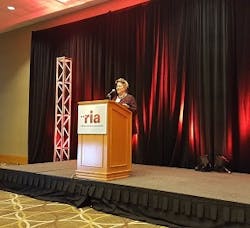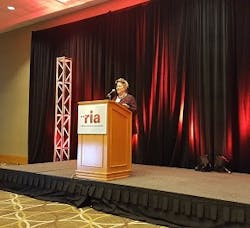Robots allowed contact with humans under new collaborative specification
ISO/TS 15066:2016, Robots and robotic devices—Collaborative robots, is a technical specification of safety requirements for collaborative industrial robot systems and the work environment. It supplements the requirements and guidance on collaborative industrial robot operation given in ISO 10218‑1 and ISO 10218‑2, Robots and robotic devices—Safety requirements for industrial robots standards.
Roberta Nelson Shea, global technical compliance officer at Universal Robots, provided an introduction to the ISO/TS 15066:2016 technical specification. "What is a technical specification," asked Nelson Shea at the 2016 National Robot Safety Conference in Cincinnati, hosted by Robotic Industries Assn. "ANSI doesn't have technical specifications; it has a standard or a technical report. In the ISO world, there are actually three tiers, a standard, technical specification and technical report. It's more than a technical report and is expected to become a standard. An ISO/TS technical specification is a voluntary document with normative language representing technical consensus of the committee. What it means is the topic is expected to be turned into a standard at some point in time in the near future. The technical specification is not quite ready for primetime."
This ISO/TS 15066 technical specification provides guidance not available in the ISO 10218-1 and -2 robot safety standard. While the safety standard does discuss collaborative operation of robots, there was so much demand for collaborative information, the technical specification was written.
Some understanding of terminology helps. "An important terminology from ISO 10218 is the definition of a robot and a robot system," said Nelson Shea. "A robot is the robot arm and robot controller. A robot system is the robot, end effector and workpiece. What is being done is the application?"
Another terminology is collaborative robot, which is a robot that can be used for collaborative operation, said Nelson Shea. "It enables a purposely designed robot system to work in direct cooperation with a human or near a human within a defined workspace," she said. "Collaborative operation is defined by the task, which is what the robot system is doing, and the space in which the task is being performed."
Collaborative operation is not the robot alone, said Nelson Shea. "If robot contact with a human results in no harm, it maybe be acceptable for use in a collaborative application," she continued. "However, if the robot is wimpy—inherently safe—or a power-and-force-limited robot and the application is manipulating a knife, is this an acceptable collaborative application? No. It should be properly guarded."
There was much discussion on the four types of collaborative operation, safety-rated monitored stop, hand-guided, speed and separation monitoring, and power and force limited. "With regard to power and force limited applications, the specification includes a table of impact pressures and forces with conservative values for threshold to pain based on contact between a person and part of a robot system," said Nelson Shea. "It's important to understand the two concepts here. One is called quasi-static contact and the other transient contact. Quasi is like clamping—it's pressure, squeezing that could cause significant damage if a hand is trapped, for example. Transient is more like a bump or knock. A person can take a very high transient contract."
“If the robot is wimpy—inherently safe—or a power-and-force-limited robot and the application is manipulating a knife, is this an acceptable collaborative application?” Roberta Nelson Shea, global technical compliance officer at Universal Robots, provided an introduction to the ISO/TS 15066:2016 collaborative robot technical specification at RIA’s 2016 National Robot Safety Conference.
A study by University of Mainz in Germany used 100 subjects and 29 body regions to determine acceptable and unacceptable onset-of-pain regions of force or pressure to determine the maximum transient value and maximum quasi-static values for relevant body regions. These maximum values allow more interaction and sometimes contact between the robot system and people. It doesn't hurt, but it might. These low-risk applications do not require traditional safeguarding.
A risk assessment is still required—see RIA TR R15.306-2016, Task-based Risk Assessment Methodology. "The risk assessment needs to consider potential impact," said Nelson Shea. "Do not presume that a robot can be used for collaborative operation—the application determines whether the robot system can be collaborative. The new technical specification adds more safety, enabling more creative robot applications."
RELATED: Important standards, regulations when designing equipment that includes robots
About the Author

Dave Perkon
Technical Editor
Dave Perkon is contributing editor for Control Design. He has engineered and managed automation projects for Fortune 500 companies in the medical, automotive, semiconductor, defense and solar industries.

Leaders relevant to this article:


